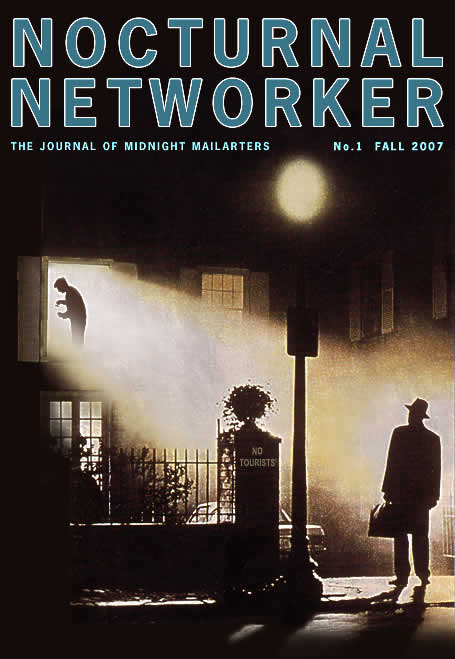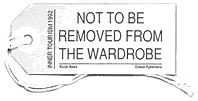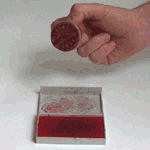Mail Art and Tourism
In 1983 I was introduced to the radical concept of Mail Art and discovered a Network available to anyone who can afford the postage stamps, an alternative world outside gallery or commercial systems, where artworks are not judged or excluded. I found a rich source of ideas and art practices that increased my awareness and tolerance of other views and interests. Above all, I could sample the world via the international postal service - I could experience the work of distant artists, their personality and their environment, all from afar. �

Mail Art was different not just because it sidestepped the official Art World with its emphasis on profit, reputation and exclusion, Mail Art, despite the separation between correspondents, was friendly, it was artist-centered rather than being centered around the Arts.� A traditional art practice might involve artists uprooting and working in a centre such as Paris or New York where artists could enjoy the sense of community that close proximity can bring, and were accessible to the art establishment of studios, critics, galleries and customers. Correspondence, however, would allow Mailartists the freedom to bypass centralised systems. Could communication through the International Postal System break down barriers? Could the spirit of Mail Art, of free admission and exchange, foster a wider, non-exclusive community based on proxy not proximity. � ��

The great experiment of Mail Art, precursor to the world wide web, was a network supporting an infinite number of virtual communities of artists. Could community values such as friendship, mutual respect, co-operation, trust and tolerance really thrive amongst distant participants? Without the handshake. No eye to eye. Without the coffee or the beer. Could Mail Art change the world?� � ��
Although Mailartists from Ray Johnson onwards have sometimes met up, Ray's legacy is in the post. It is an example available to all irrespective of geography (or gender, or class, or lifestyle, etc), a forward looking vision of a world 'together apart'. All you need is stamps. � � ��
Tourism masqueraded as innovation, the new ism that elevated the status of the Meeting above the Mail Art. It wasn't hard to do, just slip back into conventional community mode. Meetings are charged with sense data - eye contact, gossip, laughter, novelty sitiuations, tastes and smells, movement, travel. The Mailartist might have a mere envelope and its contents to engage the recipient - a much tougher task.� � � ��

Networker Statement�
There has long been a practice of artists learning together in schools,
forming groups and movements and more recently working in collectives.
What fired my enthusiasm for mail art back in the early eighties
was the peculiar idea of people working in physical isolation,
giving, receiving, bouncing ideas off artists they never meet.
They never meet.
I still find the interplay between distant networkers
the most fascinating aspect of mail art.
It is after all an aspect which anticipated working patterns made possible
by new technology.
It is after all an aspect which anticipated working patterns made possible
by new technology.
Yet not only is the solitude of mailartists uncelebrated, unexplored and undocumented,
there is also an historiscist assumption that the personal, physical contact
is the natural or logical development for mail art.
Is the natural or logical development for mail art?
For the upwardly and outwardly mobile, mail art has become
the letter of introduction and the passport to something else.
I don't like the something else.
Join with me, the Eclectic Hermit.
Investigate the physical isolation and conceptual affiliation that is mail art.
I do not want to meet you. �� � � ��

The dynamic of Tourism was the dynamic of tourism. Tourists were active, sensation-seeking travellers, publicists, diarists and letter-writers who were full of their experiences. They thought of themselves as the avant-garde, outflanking the postman. The de rigueur photocopied photographs of congress meetings proliferated. To be on the Mail Art map, to be an important Mailartist or even a real Mailartist, you had to congress. Mail Art's contradictory future would be the return to a physical community of artists.� � ��
I Touristed in 1986 to the Decentralised Congress at the Tate Gallery in not-so-decentralised London. A sandwich of two long journeys by rail from Manchester filled with the basement cafe at the Tate and a nearby pub. A bit of rubberstamping, some more or less awkward chatting and a lot of standing around. I certainly felt the fascination of putting faces to the mailings, but we gossiped and discussed nothing of worth. I learned that Michael and Hazel hated cigarette smoking and I learned that I felt uncomfortable with the whole Tourist thing. �� � ��
And so the shy Eclectic Hermit was invented, the English Suppressionist. And the anti-Tourist. A personal choice. I still say if you have the time and the money, the inclination and the invitation, go forth and visit. I don't have a problem with Mailartists visiting other Mailartists. But it threatened to become an expectation, an obligation, and it was not a progression from Mail Art. The gospel of Tourism was retrogressive.� � � ��
The Eclectic Hermit�
The wall of decent distance
Screens the eclectic hermit
From others within the envelope of his world.
No tourist or congressman he,
Into his ready retreat
A trickle of emissions has replaced
The impassioned pace of newlywed networking.
And his receipts,
The pollutions and perfections,
Are now sufficient scaffolding;
He can hang
To be reborn making representations,
Forging elemental fusion,
Bastardly and motley.
He can touch equally isolated outcrops
Of alien nation,
In conceptions borne by air
Will he scatter signposts.
��
I really enjoyed Vittore Baroni's Incongruous Meetings project of 1998, its tongue-in-cheek stance suggested negative aspects to mail art congresses.���
Incongruous Rendezvous
When Harry met Shirley I wasn't there.
When Vittore met Gorey I was needed elsewhere.
When Serge met Shozo and Steve met Cesar,
I just couldn't make it, I thought it too far.
Incongruous rendezvous.
Klaus met Clemente and Jacques met Jilly,
I was unavailable, perhaps I was ill,
When PLG met CJK,
I'll take a raincheck, I've not much to say.
Incongruous rendezvous.
Marcello met Magda, Guido met Guy.
Ruud met Rod and that's as it should be,
but Michael, Mark, Luce and John
could not convince me to congress on.
Incongruous rendezvous.
I will write you if you write me or mail down the line,
but mail art is mail art and it takes me some time,
If Ray came back and called me on the telephone
I'd have to pretend that there was no-one home.
Incongruous rendezvous.
I'll take a sabbatical, I'm unavailable, I'll take a raincheck,
I have an alibi, I'm missing in action, give me a postal vote.�
�

I think that Mail Art is such a great concept, and it's more than 'penfriends with pictures'. Mail Art feeds the artist inside everyone who plays the game, and it enables participants to have big ideas. Mail Art is ideally placed to document a modern world in which we increasingly find our perceptions delivered by carrier.�
I'd be a bit upset if people remembered me for my 1986 jaunt, or the letters I include with my Mail Art. They are trivia, they are gossip, they are a clue to my apologetic nature and a tiny insight into a hectic life. They are my underpants. I am not David Zack and they are seldom poetic.�
The whole Congress/Tourist thing was too close to the penfriend exchange visit, the gossip group, or rubberstampers at a craft fayre. Congresses create smalltalk. As David Dellafiora says,�
"The first time I met Theo Breuer, that experience made us better correspondents in that we could share the history that we had met each other." (The David Dellafiora Tape Interview , 'Kairan' #2)�
I rest my case.�


